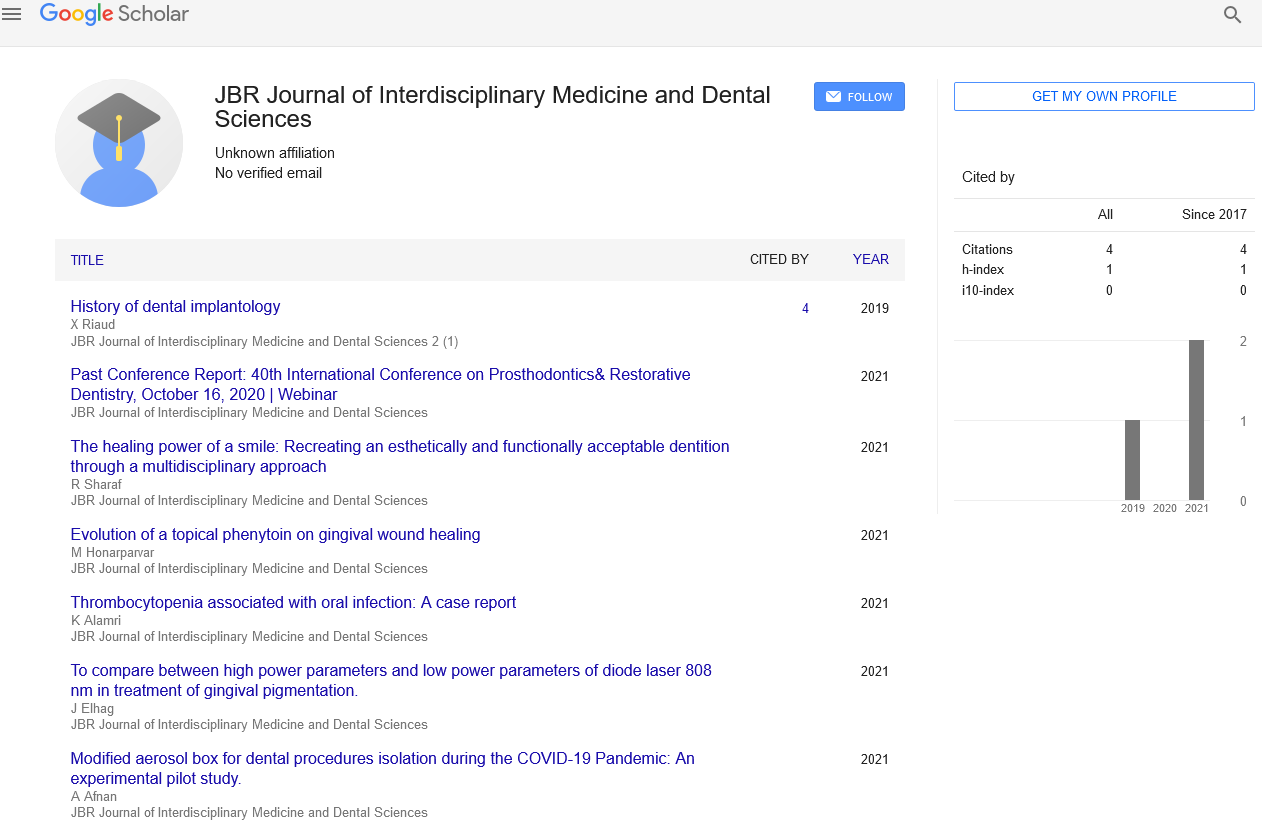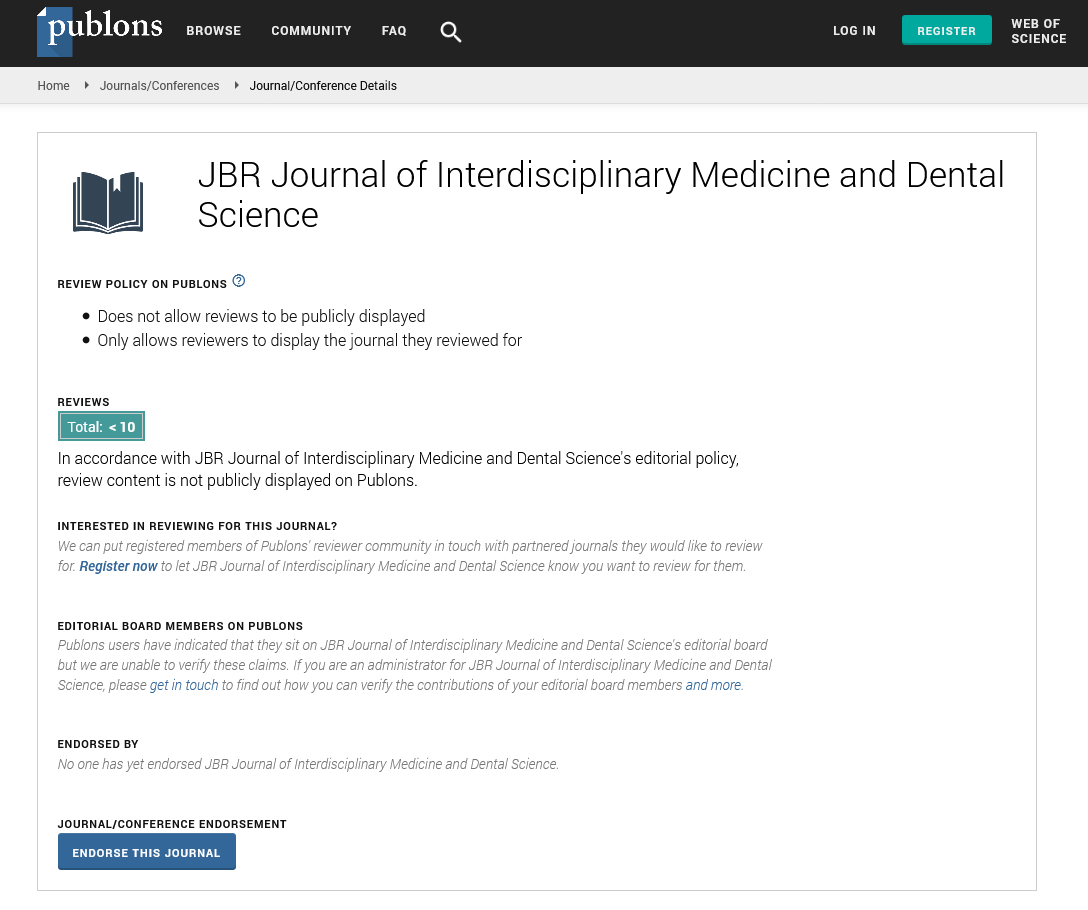Short Communication - JBR Journal of Interdisciplinary Medicine and Dental Sciences (2023) Volume 6, Issue 3
Embracing the Power of the Multidisciplinary Approach Breaking Boundaries and Fostering Innovation
Rechard Levain*
Department of Pharmacology, Australia
Department of Pharmacology, Australia
E-mail: levain_r14@gmail.com
Received: 01-May-2023, Manuscript No. jimds-23-100128; Editor assigned: 04-May-2023, PreQC No. jimds-23-100128 (PQ); Reviewed: 19-May-2023, QC No. jimds-23-100128; Revised: 24-May-2023, Manuscript No. jimds-23-100128 (R); Published: 30-May-2023, DOI: 10.37532/2376- 032X.2023.6(3).39-42
Abstract
In today’s rapidly evolving world, tackling complex challenges requires a fresh and comprehensive approach to problem-solving. The multidisciplinary approach has emerged as a powerful strategy that brings together insights, methodologies, and expertise from diverse fields to address these complex issues. By transcending traditional disciplinary boundaries, the multidisciplinary approach encourages collaboration and fosters innovation, enabling us to address problems from multiple perspectives and unlock transformative solutions. Traditionally, experts worked within the confines of their own fields, often unaware of advancements and insights made in other disciplines. This soloed approach limited the potential for cross-pollination of ideas and hindered progress in finding effective solutions. However, the multidisciplinary approach breaks down these barriers, emphasizing collaboration and knowledge exchange between different fields. By leveraging the collective expertise of various disciplines, this approach allows for a more comprehensive understanding of complex problems and offers the opportunity to uncover connections and solutions that may otherwise remain hidden. At its core, the multidisciplinary approach emphasizes the power of diversity. When individuals from different backgrounds, expertise, and perspectives come together, they bring unique insights and problem-solving approaches. The integration of diverse knowledge domains stimulates innovation by encouraging fresh thinking, creativity, and the exploration of unconventional avenues. This collaborative and inclusive approach enhances problemsolving capabilities, enabling us to tackle challenges with a broader and more nuanced lens. The multidisciplinary approach finds applications across a wide range of domains, including healthcare, environmental science, business, and technology.
Keywords
Multidisciplinary approach • Problem-solving • Innovation • Disciplines • Barriers
Introduction
In today’s rapidly evolving world, the complexity of challenges we face requires a fresh and comprehensive approach to problem-solving. The multidisciplinary approach has emerged as a powerful strategy that brings together insights, methodologies, and expertise from diverse fields to tackle these complex issues [1]. By transcending traditional disciplinary boundaries, the multidisciplinary approach encourages collaboration and fosters innovation, enabling us to address problems from multiple perspectives and unlock transformative solutions. In the past, experts often worked within the confines of their own fields, unaware of the advancements and insights made in other disciplines. This soloed approach limited the potential for cross-pollination of ideas and hindered progress in finding effective solutions. However, the multidisciplinary approach breaks down these barriers, emphasizing collaboration and knowledge exchange between different fields [2]. By leveraging the collective expertise of various disciplines, this approach allows for a more comprehensive understanding of complex problems and offers the opportunity to uncover connections and solutions that may otherwise remain hidden. At its core, the multidisciplinary approach emphasizes the power of diversity. When individuals from different backgrounds, expertise, and perspectives come together, they bring unique insights and problemsolving approaches. The integration of diverse knowledge domains stimulates innovation by encouraging fresh thinking, creativity, and the exploration of unconventional avenues. This collaborative and inclusive approach enhances problem-solving capabilities, enabling us to tackle challenges with a broader and more nuanced lens. The multidisciplinary approach finds applications across a wide range of domains, including healthcare, environmental science, business, and technology [3]. Collaborations between professionals in these fields have yielded remarkable advancements and breakthroughs, ranging from personalized medicine and sustainable practices to cuttingedge technologies like artificial intelligence and robotics. The multidisciplinary approach has proven its ability to drive progress and make significant contributions in various areas of human endeavour. However, adopting a multidisciplinary approach is not without its challenges. Bridging disciplinary gaps and fostering effective collaboration requires overcoming communication barriers, promoting mutual understanding, and building platforms that facilitate interdisciplinary exchange.
Moreover, institutional structures and funding mechanisms need to adapt to support and incentivize interdisciplinary research and collaboration. In this article, we will delve deeper into the significance of the multidisciplinary approach [4]. We will explore its benefits, applications, and the potential challenges that must be addressed to fully embrace its potential. By embracing the power of multidisciplinary collaboration, we can break free from the limitations of individual disciplines, unlock innovative solutions, and shape a future that is driven by collective wisdom and holistic thinking.
Material and Method
Defining the multidisciplinary approach
The multidisciplinary approach involves the convergence of knowledge, methodologies, and perspectives from different disciplines to address complex problems holistically. It goes beyond the traditional boundaries of individual fields, emphasizing the integration of insights from diverse disciplines such as science, technology, engineering arts, and humanities. By drawing on a range of expertise, this approach aims to foster innovation, deepen understanding, and generate novel solutions [5].
Breaking down silos for collaborative innovation
One of the primary advantages of the multidisciplinary approach is its ability to break down silos that exist between disciplines. Traditionally, experts tend to work within their respective domains, often unaware of the insights and advancements made in other fields. This isolation can hinder progress and limit the scope of potential solutions. By encouraging collaboration and knowledge exchange across disciplines, the multidisciplinary approach facilitates a more comprehensive understanding of complex issues and allows for the discovery of innovative connections and solutions that might otherwise remain hidden [6].
Enhancing problem-solving and innovation
The multidisciplinary approach brings together diverse perspectives, methodologies, and problem-solving techniques. When experts from different fields collaborate, they can leverage their unique insights to identify novel approaches and solutions [7]. The integration of different knowledge domains allows for a more comprehensive analysis of problems, leading to breakthroughs that may have been overlooked when viewed through a single disciplinary lens. This cross-pollination of ideas and expertise nurtures innovation by fostering an environment that encourages experimentation, risk-taking, and the exploration of unconventional avenues.
Applications across domains
The multidisciplinary approach has found applications across a wide range of domains. In healthcare, for example, collaborations between medical professionals, data scientists, engineers, and designers have led to advancements in telemedicine, personalized medicine, and medical technology [8]. In environmental science, collaborations between biologists, climatologists, and policy experts have informed sustainable practices and policies. Moreover, in business and technology, multidisciplinary teams have fueled breakthroughs in fields such as artificial intelligence, robotics, and biotechnology, creating transformative solutions with far-reaching implications.
Challenges and the way forward
While the multidisciplinary approach holds immense potential, it is not without challenges. Bridging disciplinary gaps and fostering effective collaboration requires effective communication, mutual respect, and a willingness to embrace diverse perspectives [9]. Institutional barriers, such as rigid academic structures and funding mechanisms that favor single-discipline research, can also impede progress. Overcoming these challenges necessitates the development of interdisciplinary programs, incentives, and platforms that promote collaboration and reward interdisciplinary research [10].
Discussion
In an increasingly complex and interconnected world, tackling complex problems and driving innovation requires more than a single perspective. The multidisciplinary approach, a strategy that integrates insights and expertise from various disciplines, has emerged as a powerful framework for addressing diverse challenges. By breaking down traditional barriers and encouraging collaboration between different fields, the multidisciplinary approach opens new pathways for creative problem-solving and paves the way for transformative breakthroughs. This article explores the significance of the multidisciplinary approach and highlights its key benefits and applications across various domains.
Conclusion
The multidisciplinary approach has become a vital tool in addressing the complexities of our modern world. By integrating insights, methodologies, and expertise from diverse fields, this approach fosters collaboration, breaks down disciplinary barriers, and drives innovation. Through the collective wisdom of multiple perspectives, the multidisciplinary approach offers a comprehensive understanding of complex problems and unlocks transformative solutions. The benefits of adopting a multidisciplinary approach are far-reaching. It enhances problemsolving capabilities, encourages creativity, and promotes unconventional thinking. In various domains such as healthcare, environmental science, business, and technology, multidisciplinary collaborations have led to remarkable advancements and breakthroughs. By bringing together professionals from different fields, we can develop personalized medical treatments, implement sustainable practices, and push the boundaries of technological innovation. However, implementing a multidisciplinary approach is not without its challenges. Effective communication, mutual respect, and the creation of interdisciplinary platforms are necessary to bridge disciplinary gaps. Additionally, institutional structures and funding mechanisms need to adapt to support and incentivize interdisciplinary research and collaboration. Embracing the power of multidisciplinary collaboration is essential for addressing the pressing issues of our time. By fostering an environment that promotes collaboration and innovation, we can leverage the collective knowledge and diverse perspectives to drive progress and shape a better future. The multidisciplinary approach offers us a path to transcend traditional disciplinary boundaries, unlock transformative breakthroughs, and create a world that thrives on collective wisdom and holistic thinking. As we move forward, let us embrace the multidisciplinary approach and harness its potential to tackle the complex challenges that lie ahead.
References
- Phramor L. Validity of claims made in weight management research: a narrative review of dietetic articles. Nutrition Journal. 9, 30 (2010).
- Long Z, Huang L, Lyu J et al. Trends of central obesity and associations with nutrients intake and daily behaviors among women of childbearing age in China. BMC Women's Health. 22, 12 (2022).
- Melina V, Craig W, Levin S et al. Position of the Academy of Nutrition and Dietetics: Vegetarian Diets. J Acad Nutr Diet.116, 1970-1980 (2016).
- Mueller-Stierlin AS, Cornet S, Peisser A et al. Implications of Dietary Intake and Eating Behaviors for People with Serious Mental Illness: A Qualitative Study. Nutrients. 14, 2616 (2022).
- Johnson VR, Washington TB, Chhabria S et al. Food as Medicine for Obesity Treatment and Management. Clinical Therapeutics. 44, 671-681 (2022).
- Partridge L, Deelen J, Slagboom PE et al. Facing up to the global challenges of ageing. Nature. 561, 45-56 (2018).
- Coman V, Vodnar DC. Gut microbiota and old age: Modulating factors and interventions for healthy longevity. Experimental Gerontology. 141, 111095 (2020).
- DeJong EN, Surette MG, Bowdish DM et al. The Gut Microbiota and Unhealthy Aging: Disentangling Cause from Consequence. Cell Host & Microbe. 28, 180-189 (2020).
- Warman DJ, Jia H, Kato H et al. The Potential Roles of Probiotics, Resistant Starch, and Resistant Proteins in Ameliorating Inflammation during Aging (Inflammaging). Nutrients. 14, 747 (2022).
- Fong BY, Chiu WK, Chan WF et al. A Review Study of a Green Diet and Healthy Ageing. Int J Environ Res 18: 8024 (2021).
Indexed at, Google Scholar, Crossref
Indexed at, Google Scholar, Crossref
Indexed at, Google Scholar, Crossref
Indexed at, Google Scholar, Crossref
Indexed at, Google Scholar, Crossref
Indexed at, Google Scholar, Crossref
Indexed at, Google Scholar, Crossref
Indexed at, Google Scholar, Crossref


